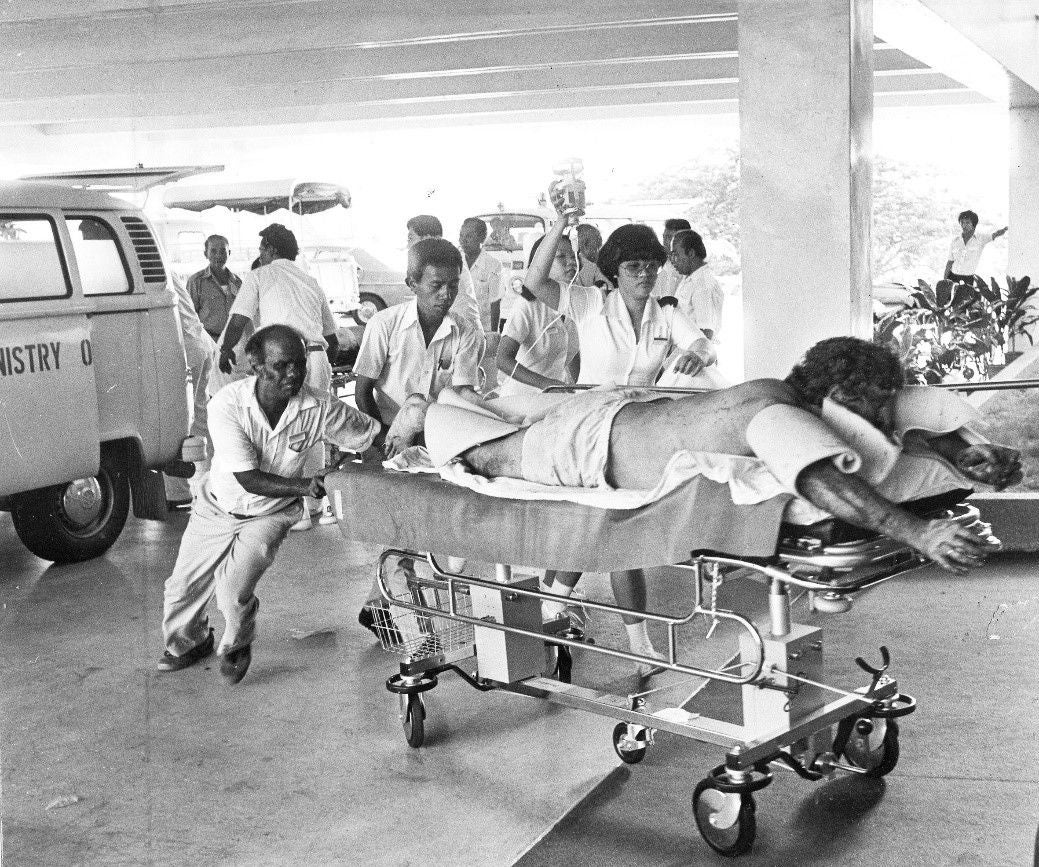
Source: Straits Times © Singapore Press Holdings Limited. Reproduced with permission.
Patients with severe burns from the Spyros explosion were arriving at our Burns Unit in SGH, literally by the lorry load.
You have probably glimpsed this image of the Spyros disaster on our SGH200 lamp post buntings. Senwan Bin Jamal from Histopathology Lab, brings us back to that eventful day, a defining moment in the SGH Story.
It’s 7.30am, the sun is rising and many of us are getting ready to start the day. But Senwan Bin Jamal is already in the Histopathology Lab, ready to start work.
Senwan, now 69 years old, has been the first onsite at the lab for the past 52 years.
Over the last half a century, Senwan has seen many changes to the sector and its protocols and procedures. He has also witnessed some of the most prominent disasters in Singapore’s recent history.
In 1969, Senwan joined Singapore General Hospital, embarking on his first proper job as a lab technician. Attached to Histopathology department, Senwan occasionally worked with forensics, assisting pathologists with cases at the mortuary.
It was in 1978 that one of the most memorable events happened for Senwan, the Spyros disaster. The Greek tanker Spyros exploded at Jurong Shipyard, killing 76 people and injuring 69 others.
“When I was called in, I was not prepared for what I was about to see. Bodies were everywhere. Our mortuary was not big enough to hold them all. They were lying side by side on the floor and we had to enlist National Service men to help us handle the sheer volume. I assisted with taking blood samples from all the bodies, and we had to be quick. We managed, and cleared everything in 3 to 4 days.”

Source: Straits Times © Singapore Press Holdings Limited. Reproduced with permission.
The collapse of Hotel New World in 1986 was Singapore’s worst civil disaster since the Spyros explosion.
Eight years later, disaster would strike again, with the collapse of Hotel New World on 15 March 1986. The six-storey building collapsed, trapping 50 people beneath the rubble. Thirty-three people died and 17 were rescued in the five-day inter-agency search and rescue.
“Bodies trickled in to the mortuary one by one. But following Spyros, we were prepared and already got two large 6-metre long freezer containers. Most of the bodies had decayed so the smell was terrible. Also - this was the time before digital cameras – whilst waiting for the bodies to come in, my colleague hurried to Chinatown to buy two polaroid cameras so that we could have instant photos. We took photos to help the families identify the deceased. I was a seasoned staff in pathology but I still felt sad whenever the families came to identify their loved one. Some of the bodies were so bloated from decay that the families could only identify them from their clothing. I remember one identifying her loved one from the tailor’s label on the trousers,” recalls Senwan.
Throughout our history, SGH has journeyed with the nation through good times and tough times. From each of these mass casualty events, we learnt and developed new protocols, and built new capabilities such as the Burn Centre, which today serves the region, not just Singapore.
These defining moments in the SGH Story are captured in the lamp post buntings on SGH Campus. If you are at SGH, look out for them:

Spyros disaster in 1978 led to the setup of the region’s only Burns Centre.


Answering the call of duty during the COVID-19 pandemic


The SGH Campus Masterplan was unveiled in 2016

Training the nation’s doctors since 1905
We love mail! Drop us a note at lighternotes@sgh.com.sg to tell us what you like or didn’t like about this story, and what you would like to see more of in LighterNotes.














 Get it on Google Play
Get it on Google Play